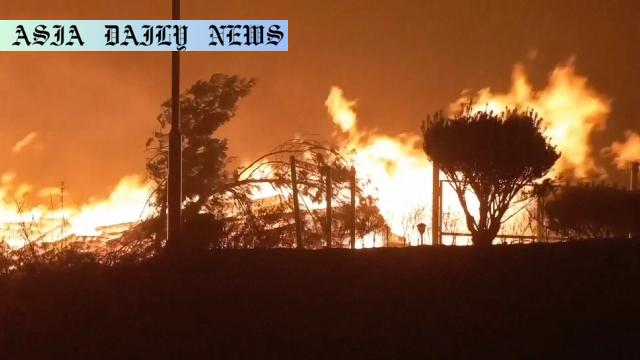Wildfires: Devastating fires fueled by dry conditions and strong winds claim 24 lives in southeastern South Korea.

Wildfires Ravage Southeastern South Korea
Since breaking out last week, devastating wildfires in South Korea have claimed the lives of 24 individuals, including brave firefighters committed to extinguishing the blaze. These uncontrollable fires are burning across the southeastern regions of the country, primarily driven by strong winds and exacerbated by prolonged dry weather conditions, presenting monumental challenges for emergency responders.
Human Toll and the Tragic Loss of Lives
Among the deceased, several individuals were found along roadways, suggesting they succumbed to the fast-moving fires while evacuating. Reports of fatalities include four firefighters who perished during their ground operations, adding to the tragedy of this disaster. Compounding this already dire situation, a firefighting helicopter crashed in North Gyeongsang Province, taking the life of the pilot and forcing officials to suspend aerial firefighting operations temporarily.
Escalating Challenges Due to Weather and Geography
Efforts to contain the wildfires have been significantly hindered by unfavorable weather conditions, with persistent strong winds fanning the flames and facilitating their rapid spread. Fire crews on the ground face immense difficulty maneuvering through mountainous terrain while trying to protect residential areas. The scope of destruction has led to increasing numbers of displaced individuals, with many residents seeking safety in temporary shelters as they anxiously await updates on the situation.
Impact on Emergency Operations
The temporary suspension of aerial resources following the helicopter crash underscored the challenges responders face in effectively combating wildfires of this magnitude. Although ground teams continue to perform critical efforts, the added strain of dangerous conditions on human resources is becoming increasingly apparent.
The Broader Implications
This disaster highlights the vulnerabilities faced by South Korea during periods of dry weather and strong winds, prompting urgent discussions about preparedness and preventative measures. As firefighters push forward with containment strategies, questions about resource availability, evacuation protocols, and long-term recovery plans dominate public discourse.
The scars of these wildfires will undoubtedly leave a lasting impression on the affected regions as authorities strive to examine and address the underlying causes of this tragedy.
Commentary
The Sobering Reality of South Korea’s Wildfires
The headlines detailing South Korea’s ongoing wildfire crisis are gut-wrenching. The sheer loss of life—24 people, including intrepid firefighters—paints a somber picture of the devastation caused by nature’s unrelenting fury. It’s harrowing to imagine the circumstances under which individuals lost their lives, some tragically caught on the roads as they sought escape from the encroaching flames. These stories underscore the profound human toll of such disasters, which ripple far beyond mere statistics into the realm of deep personal loss and societal grief.
Challenges in Combating an Unforgiving Force
Strong winds and dry conditions have become the accelerants of destruction in South Korea’s southeastern regions, creating a near-perfect storm for the spread of wildfires. The crash of a firefighting helicopter and the loss of four ground firefighters serve as a stark reminder of the peril emergency workers face. Their heroism amidst immense adversity cannot go unacknowledged. Yet, their losses also signify how dangerous and unpredictable such disasters can be, often outpacing even the most prepared rescue operations. It raises questions about whether additional resources and predictive systems could help mitigate such tragedies in the future.
Looking Toward the Future
What lessons can be drawn from these fires? For South Korea and nations globally, the efficacy of preventive measures, evacuation protocols, and resource allocation are recurring themes in the aftermath of such disasters. As the climate becomes increasingly volatile, governments and communities must prioritize preparedness. Improvements in fire safety education, infrastructure to support evacuation, and bolstering response teams are essential steps toward minimizing human and environmental costs. While these wildfires rage on, we must unite to confront these challenges with resilience and collective action, ensuring that such devastation does not occur unchecked again.


